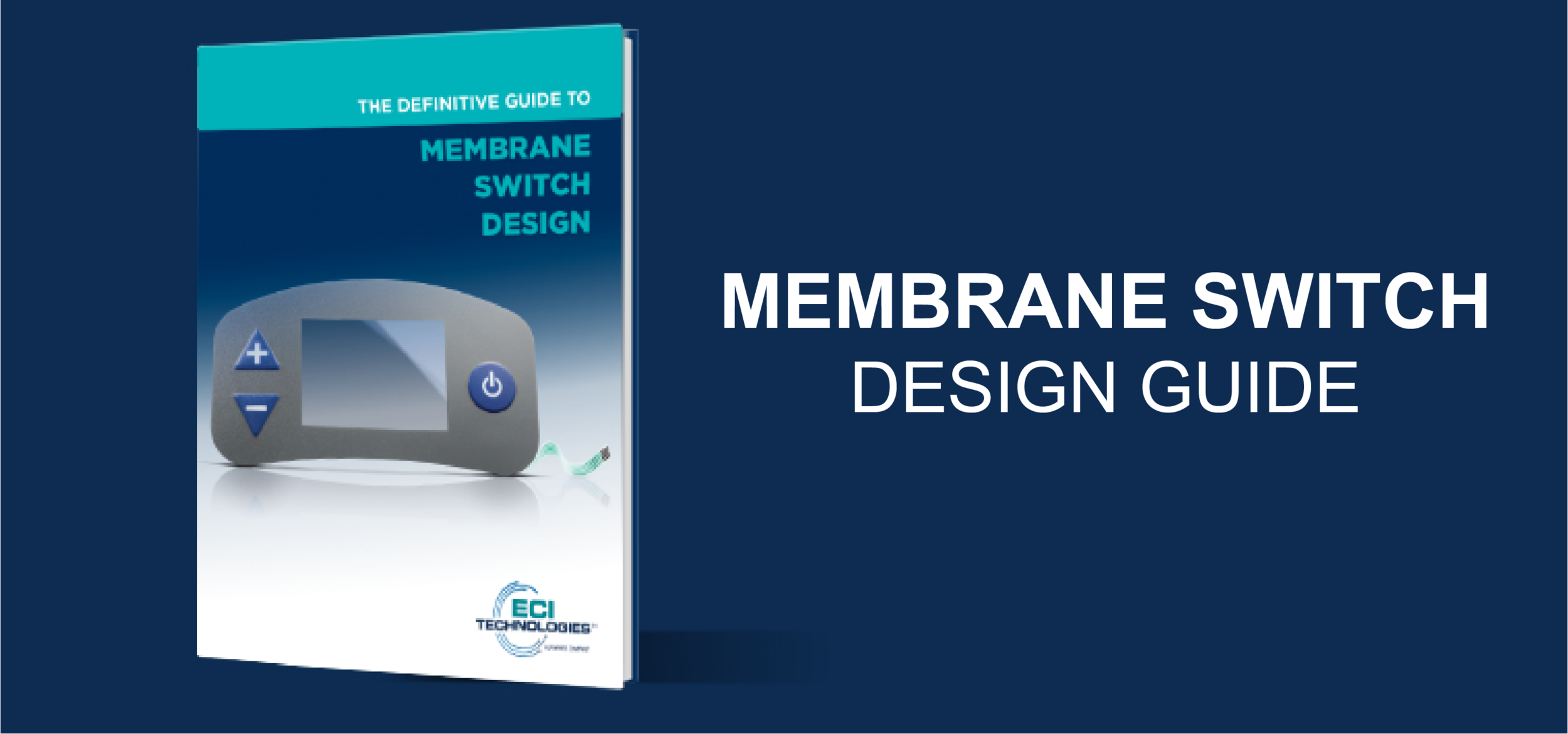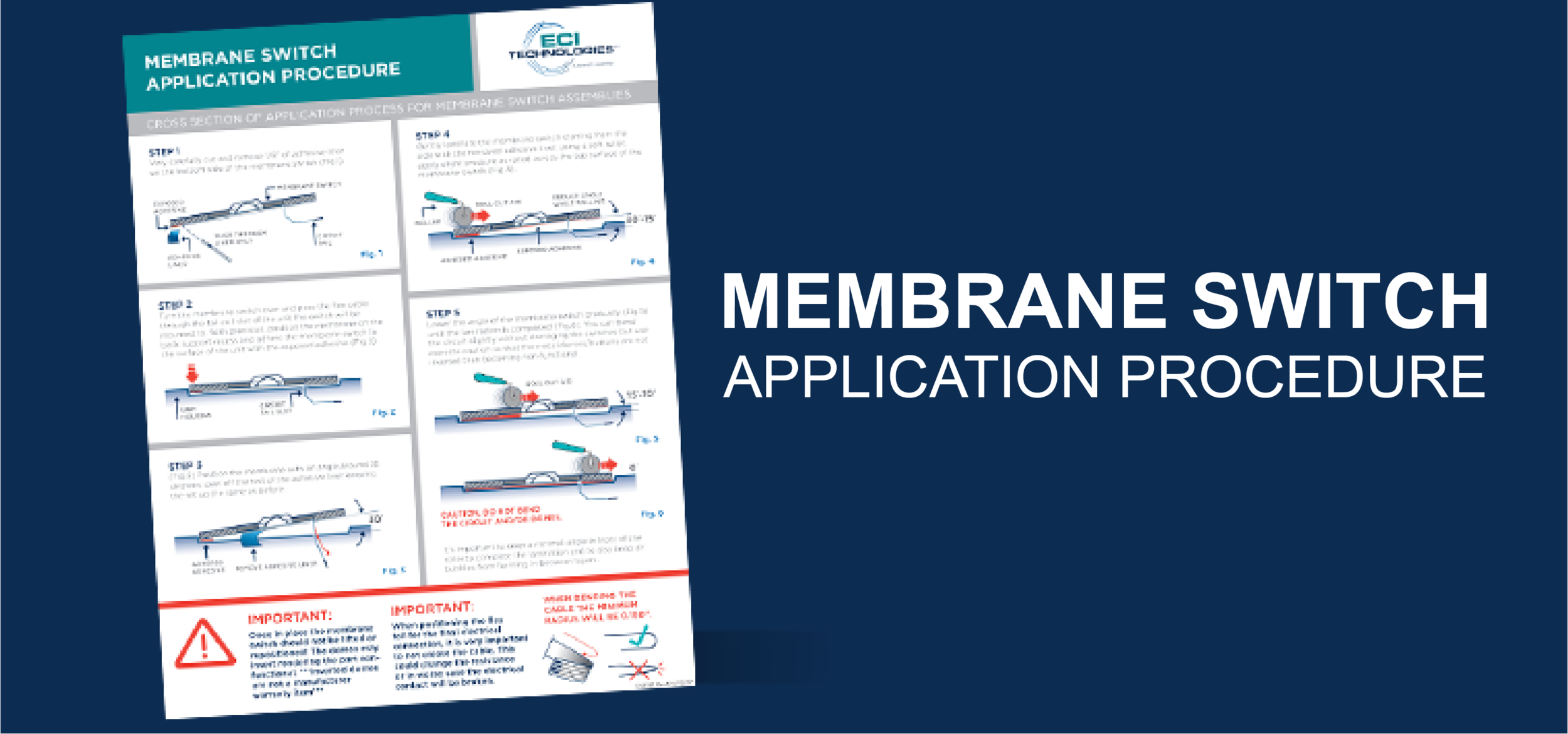MEMBRANE SWITCHES
A membrane switch is a low power electrical switch, comprised of silver or graphite impregnated ink, printed and cure bonded to a plastic substrate - polyester being the most common - and assembled with various adhesive layers and finished with a graphic overlay. Major benefits in designing a membrane switch into your product include ease of cleaning, environmental sealing, low profile, and the ability to create a visually attractive interface.
ECI uses state of the art design and production techniques, material and components to produce simple to complex membrane switch and membrane keypad assemblies. We will also utilize our extensive experience in the design and manufacture of membrane switches to ensure that your product has an interface that excels in ergonomic performance and durability while achieving the esthetics you need to set your product apart from the competition.
Our Membrane Switch products can include:
Tactile and non-tactile Membrane Keypads
Non-tactile membrane switches have no defined feel when actuated so a different stimulus such as audio or visual feedback is needed. A good example would be the controls for most microwave ovens which normally have no tactility and use audible feedback as the stimulus to inform the user that a connection has been made. Non-tactile membrane switches are not as prevalent as tactile as users prefer to experience a defined click or snap when a key is depressed.Tactile membrane switches have become the norm and give the user definitive feedback when actuated.
Tactility can be produced through several methods:
Internal Polydomes: Embossed into the top circuit or shorting layer. This method makes sense when there are many keys as it can positively affect the cost in application.
External Polydomes: Embossed into the graphic overlay. The same advantages are as those above but also gives the user a “bump” indicating where each key is.
Metal Domes: Individually placed component that creates a definitive “snap” when actuated. This method is the most common as the feel is the most uniform and offers many different sizes and trip forces.
COMPREHENSIVE MEMBRANE SWITCH SOURCE
In this Membrane Switch White Paper, we’ll go over everything you need to know about membrane switches.
Backlit Keypads
ECI Technologies has established itself as one of the industry’s backlighting specialists. Using different methods, backlighting membrane switches not only allows nighttime view ability but can also greatly enhance the esthetics of the interface. Backlighting can be produced with:
Light Emitting Diodes or LED’s:With the advent of “Side Fire” LED’s, designers no longer have to work around the hot spots that can occur when a traditional “top fire” LED is used. Strategically placed “Side Fire“ LED’s will create a seamless, uniform backlight for keys, nomenclature and company logos.
Light Guide Film: Light guide film is created through strategically placed, and numbered “dimples” or indents that gather light from LED’s and then diffuse, direct and transport that light to certain locations creating uniform lighting and eliminating hot spots.
Fiber Optics: A fiber optic backlight is created with two or more layers of woven fiber-optic cloth to form a light-emitting area. The fibers coming off one end are then bundled into a circular bezel that captures one or more LED light sources. Because Fiber Optics uses LED’s for its light source the life for this method can be 50,000 hours. Fiber Optics are not affected by extremes in humidity (0% to 100%) or temperature (-40 to +85 deg. C) which make them perfect for harsh environments.
Electroluminescent or (EL) Lamps: These offer a lower cost and additional design flexibility when compared with fiber optics. The color of the light emitted from an EL lamp can vary depending on the phosphors. Common colors are blue/green and yellow/green, white, blue and orange. EL lamps do have drawbacks as they have a half-life of approximately 3000–8000 hours and once they reach their half-life the brightness starts to fade rapidly. They are also difficult to see in daylight and additional electronics are necessary to “drive” EL lamps.
ECI TAKES YOUR IDEAS AND BRINGS THEM TO LIFE.
OUR EXPERIENCED TEAM UTILIZES MATERIALS AND TECHNIQUES THAT ARE BEST SUITED FOR YOUR APPLICATION AND AESTHETIC REQUIREMENTS. WE CONTINUALLY TEST NEW MATERIALS, PRODUCTS AND INKS IN A VARIETY OF APPLICATIONS TO CONSISTENTLY OFFER THE HIGHEST QUALITY OPTIONS FOR YOU.
Abuse Resistant ECI "Armor Switch" for Ruggedized Membrane Switches
This is a proprietary design that ECI uses when designing for high use and potentially abusive environments. It can increase the life of the overlay by 20x and the switch by 30x as well as enhancing the tactile feel of the keys. The attributes of ECI’s “Armor Switch” make it a good choice for military components and equipment, agricultural equipment, construction equipment and any other product that may be in an environment that can be abusive in nature. The added cost in the design and materials of the “Armor Switch” is minimal when compared to the advantages. If your product needs to be more robust than normal, ECI’s “Armor Switch” is the answer.
PCB Based Membrane Switches
If your design calls for many components, the need for vias, through hole components, different types of interconnections or the stability that a rigid board gives, then ECI can design a PCB based keypad. PCB’s can be single or multi layered and can include mounting hardware and different types of plating. PCB based designs are ideal when LCD’s or Vacuum fluorescent displays are included in the final assembly.
FPC – Flexible Printed Circuits
FPC’s combine the best of both PET based circuits and PCB’s as they offer flexibility and solder ability. The tail, as with a PET based switch, is an integral part of the circuit which saves the cost of a ribbon cable and interconnect.
Environmentally Sealed
Membrane switches can be sealed from the environment several ways. The most common is to create a continuous “frame” around the switch that is hidden from the user by the overlay. Another method is to design the switch to be mounted from the back or bottom and include a gasket on the perimeter of the overlay.















